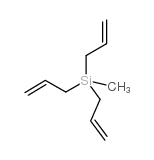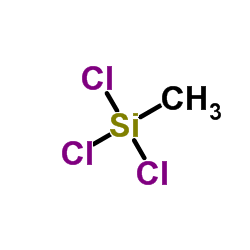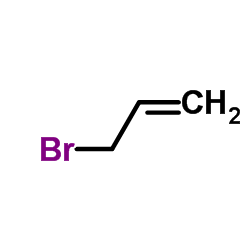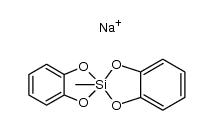1112-91-0
| 中文名 | 甲基三烯丙基硅烷 |
|---|---|
| 英文名 | methyl-tris(prop-2-enyl)silane |
| 英文别名 |
methyltriallylsilane
triallyl(methyl)silane Methyl-triallylsilan Triallyl-methyl-silan Silane,methyltri-2-propen-1-yl |
| 密度 | 0.775g/cm3 |
|---|---|
| 沸点 | 95ºC (52 mmHg) |
| 分子式 | C10H18Si |
| 分子量 | 166.33500 |
| 闪点 | 22ºC |
| 精确质量 | 166.11800 |
| LogP | 3.62300 |
| 外观性状 | 液体;Colorless to Almost colorless clear liquid |
| 蒸汽压 | 1.88mmHg at 25°C |
| 折射率 | 1.4661-1.4681 |
| 储存条件 | 密封储存,储存于阴凉、干燥的库房。远离火源,易燃易爆区。 |
| 稳定性 | 避免与不相容材料接触。
与强氧化剂反应。 |
| 分子结构 | 1、摩尔折射率:56.27 2、摩尔体积(cm3/mol):214.6 3、等张比容(90.2K):456.1 4、表面张力(dyne/cm):20.4 5、介电常数:无可用的 6、极化率(10-24cm3):22.3 7、单一同位素质量:166.117777 Da 8、标称质量:166 Da 9、平均质量:166.3354 Da |
| 计算化学 | 1.疏水参数计算参考值(XlogP):无 2.氢键供体数量:0 3.氢键受体数量:0 4.可旋转化学键数量:6 5.互变异构体数量:无 6.拓扑分子极性表面积0 7.重原子数量:11 8.表面电荷:0 9.复杂度:120 10.同位素原子数量:0 11.确定原子立构中心数量:0 12.不确定原子立构中心数量:0 13.确定化学键立构中心数量:0 14.不确定化学键立构中心数量:0 15.共价键单元数量:1 |
| 更多 | 1. 性状:无色透明液体 2. 密度(g/mL,25℃):未确定 3. 相对蒸汽密度(g/mL,空气=1):未确定 4. 熔点(ºC):未确定 5. 沸点(ºC,常压):未确定 6. 沸点(ºC,52mmHg):95 7. 折射率(n20/D):1.4661-1.4681 8. 闪点(ºC):22 9. 比旋光度(º):未确定 10. 自燃点或引燃温度(ºC):未确定 11. 蒸气压(kPa,55ºC):未确定 12. 饱和蒸气压(kPa,25ºC):未确定 13. 燃烧热(KJ/mol):未确定 14. 临界温度(ºC):未确定 15. 临界压力(KPa):未确定 16. 油水(辛醇/水)分配系数的对数值:未确定 17. 爆炸上限(%,V/V):未确定 18. 爆炸下限(%,V/V):未确定 19. 溶解性:未确定 |
Synonym:None known Section 2 - COMPOSITION, INFORMATION ON INGREDIENTS
Risk Phrases: 23/24/25 48 Section 3 - HAZARDS IDENTIFICATION EMERGENCY OVERVIEW
Toxic by inhalation, in contact with skin and if swallowed. Danger of serious damage to health by prolonged exposure.The toxicological properties of this material have not been fully investigated. Potential Health Effects Eye: May cause eye irritation. Skin: May cause skin irritation. Toxic in contact with skin. Ingestion: May cause irritation of the digestive tract. Poison by ingestion. The toxicological properties of this substance have not been fully investigated. Inhalation: May cause respiratory tract irritation. The toxicological properties of this substance have not been fully investigated. Toxic if inhaled. Chronic: No information found. Section 4 - FIRST AID MEASURES Eyes: Immediately flush eyes with plenty of water for at least 15 minutes, occasionally lifting the upper and lower eyelids. Get medical aid immediately. Skin: Get medical aid immediately. Immediately flush skin with plenty of water for at least 15 minutes while removing contaminated clothing and shoes. Wash clothing before reuse. Ingestion: Never give anything by mouth to an unconscious person. Get medical aid immediately. Do NOT induce vomiting. If conscious and alert, rinse mouth and drink 2-4 cupfuls of milk or water. Wash mouth out with water. Inhalation: Remove from exposure and move to fresh air immediately. If not breathing, give artificial respiration. If breathing is difficult, give oxygen. Get medical aid. Do NOT use mouth-to-mouth resuscitation. Notes to Physician: Section 5 - FIRE FIGHTING MEASURES General Information: As in any fire, wear a self-contained breathing apparatus in pressure-demand, MSHA/NIOSH (approved or equivalent), and full protective gear. During a fire, irritating and highly toxic gases may be generated by thermal decomposition or combustion. Use water spray to keep fire-exposed containers cool. Vapors may be heavier than air. They can spread along the ground and collect in low or confined areas. Contact with metals may evolve flammable hydrogen gas. Containers may explode when heated. Combustible material; may burn but does not ignite readily. Extinguishing Media: Do NOT get water inside containers. For small fires, use dry chemical, carbon dioxide, or water spray. For large fires, use dry chemical, carbon dioxide, alcohol-resistant foam, or water spray. Cool containers with flooding quantities of water until well after fire is out. Section 6 - ACCIDENTAL RELEASE MEASURES General Information: Use proper personal protective equipment as indicated in Section 8. Spills/Leaks: Absorb spill with inert material (e.g. vermiculite, sand or earth), then place in suitable container. Avoid runoff into storm sewers and ditches which lead to waterways. Clean up spills immediately, observing precautions in the Protective Equipment section. Remove all sources of ignition. Provide ventilation. Section 7 - HANDLING and STORAGE Handling: Wash thoroughly after handling. Avoid contact with eyes, skin, and clothing. Do not breathe dust, vapor, mist, or gas. Keep container tightly closed. Avoid ingestion and inhalation. Use only in a chemical fume hood. Storage: Store in a tightly closed container. Store in a cool, dry, well-ventilated area away from incompatible substances. Section 8 - EXPOSURE CONTROLS, PERSONAL PROTECTION Engineering Controls: Facilities storing or utilizing this material should be equipped with an eyewash facility and a safety shower. Use adequate ventilation to keep airborne concentrations low. Exposure Limits CAS# 1112-91-0: Personal Protective Equipment Eyes: Wear appropriate protective eyeglasses or chemical safety goggles as described by OSHA's eye and face protection regulations in 29 CFR 1910.133 or European Standard EN166. Skin: Wear appropriate protective gloves to prevent skin exposure. Clothing: Wear appropriate protective clothing to prevent skin exposure. Respirators: A respiratory protection program that meets OSHA's 29 CFR 1910.134 and ANSI Z88.2 requirements or European Standard EN 149 must be followed whenever workplace conditions warrant respirator use. Section 9 - PHYSICAL AND CHEMICAL PROPERTIES Physical State: Liquid Color: colorless Odor: none reported pH: Not available. Vapor Pressure: Not available. Viscosity: Not available. Boiling Point: 95 deg C Freezing/Melting Point: Not available. Autoignition Temperature: Not available. Flash Point: Not available. Explosion Limits, lower: Not available. Explosion Limits, upper: Not available. Decomposition Temperature: Solubility in water: Specific Gravity/Density: Molecular Formula: C10H18Si Molecular Weight: 166.2115 Section 10 - STABILITY AND REACTIVITY Chemical Stability: Stable at room temperature in closed containers under normal storage and handling conditions. Conditions to Avoid: Incompatible materials, ignition sources, excess heat. Incompatibilities with Other Materials: Oxidizing agents. Hazardous Decomposition Products: Carbon monoxide, irritating and toxic fumes and gases, carbon dioxide, oxides of silicon. Hazardous Polymerization: Has not been reported Section 11 - TOXICOLOGICAL INFORMATION RTECS#: CAS# 1112-91-0 unlisted. LD50/LC50: Not available. Carcinogenicity: Methyltriallylsilane - Not listed by ACGIH, IARC, or NTP. Section 12 - ECOLOGICAL INFORMATION Section 13 - DISPOSAL CONSIDERATIONS Dispose of in a manner consistent with federal, state, and local regulations. Section 14 - TRANSPORT INFORMATION IATA Shipping Name: TOXIC LIQUID, ORGANIC, N.O.S.* Hazard Class: 6.1 UN Number: 2810 Packing Group: III IMO Shipping Name: TOXIC LIQUID, ORGANIC, N.O.S. Hazard Class: 6.1 UN Number: 2810 Packing Group: III RID/ADR Shipping Name: TOXIC LIQUID, ORGANIC, N.O.S. Hazard Class: 6.1 UN Number: 2810 Packing group: III Section 15 - REGULATORY INFORMATION European/International Regulations European Labeling in Accordance with EC Directives Hazard Symbols: T Risk Phrases: R 23/24/25 Toxic by inhalation, in contact with skin and if swallowed. R 48 Danger of serious damage to health by prolonged exposure. Safety Phrases: S 28 After contact with skin, wash immediately with... S 28A After contact with skin, wash immediately with plenty of water. S 36/37/39 Wear suitable protective clothing, gloves and eye/face protection. S 37 Wear suitable gloves. S 38 In case of insufficient ventilation, wear suitable respiratory equipment. S 45 In case of accident or if you feel unwell, seek medical advice immediately (show the label where possible). WGK (Water Danger/Protection) CAS# 1112-91-0: No information available. Canada None of the chemicals in this product are listed on the DSL/NDSL list. CAS# 1112-91-0 is not listed on Canada's Ingredient Disclosure List. US FEDERAL TSCA CAS# 1112-91-0 is not listed on the TSCA inventory. It is for research and development use only. SECTION 16 - ADDITIONAL INFORMATION N/A |
|
生态学数据: 对环境有危害,对水体有污染,禁止进入水体。
|
| 危害码 (欧洲) | Xi: Irritant; |
|---|---|
| 风险声明 (欧洲) | R36/37/38 |
| 安全声明 (欧洲) | 37/39-26-16 |
| 危险品运输编码 | UN 1993 3/PG III |
| 包装等级 | III |
| 海关编码 | 2931900090 |
|
~99% 
1112-91-0 |
| 文献:Journal of Organometallic Chemistry, , vol. 691, # 22 p. 4740 - 4746 |
|
~60% 
1112-91-0 |
| 文献:Doklady Akademii Nauk SSSR, , vol. 92, p. 515 - 517 C. A., , p. 6831 Doklady Akademii Nauk SSSR, , vol. 80, p. 761 - 764 Si: MVol.C, 16, page 48 - 53 |
|
~80% 
1112-91-0 |
| 文献:J. Gen. Chem. USSR (Engl. Transl.), , vol. 58, # 7 p. 1599 - 1606,1425 - 1431 |
|
~61% 
1112-91-0 |
| 文献:Doklady Akademii Nauk SSSR, , vol. 92, p. 515 - 517 C. A., , p. 6831 Doklady Akademii Nauk SSSR, , vol. 80, p. 761 - 764 Si: MVol.C, 16, page 48 - 53 |
|
~63% 
1112-91-0 |
| 文献:Bulletin of the Chemical Society of Japan, , vol. 61, # 1 p. 101 - 106 |
|
~60% 
1112-91-0 |
| 文献:Angewandte Chemie, , vol. 98, # 5 p. 472 - 473 |
|
~% 
1112-91-0 |
| 文献:Journal of Organometallic Chemistry, , vol. 84, p. 199 - 229 Doklady Akademii Nauk SSSR, , vol. 80, p. 761,763 Chem.Abstr., , p. 11102 |
| 上游产品 7 | |
|---|---|
| 下游产品 0 | |
| 海关编码 | 2931900090 |
|---|---|
| 中文概述 | 2931900090. 其他有机-无机化合物. 增值税率:17.0%. 退税率:13.0%. 监管条件:AB(入境货物通关单,出境货物通关单). 最惠国关税:6.5%. 普通关税:30.0% |
| Summary | 2931900090. other organo-inorganic compounds. VAT:17.0%. Tax rebate rate:13.0%. Supervision conditions:AB(certificate of inspection for goods inward,certificate of inspection for goods outward). MFN tariff:6.5%. General tariff:30.0% |








